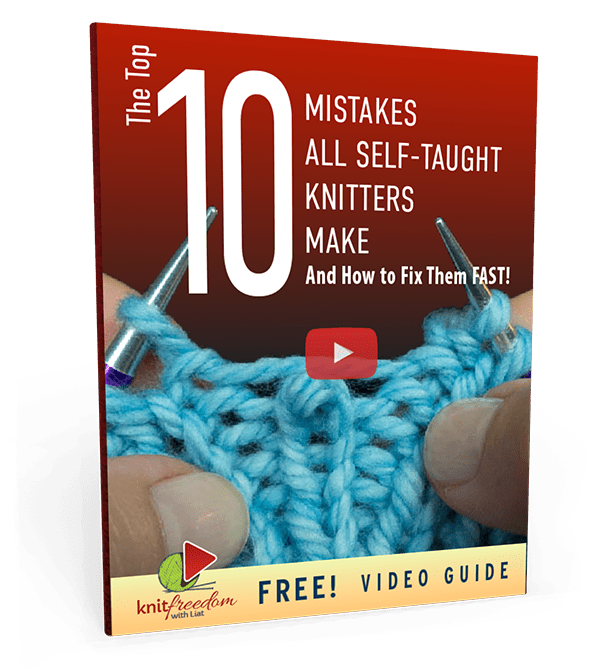This chapter is part of our Magic Loop Socks, Toe-Up Socks Video Class. Click here to learn more.
Basic Fleegle Heel Toe-Up Sock Formula
There are many sock patterns available in books and on the Internet, and many more variations you can make using the techniques above.
But let's say you want to design your own basic toe-up sock pattern like the one you learned here, with any yarn or needles you have. The formula is really easy - I must give credit to Fleegle, who published this easy formula for us all to enjoy.
I describe it to you in my own words here.
❤️ How to Knit Basic Fleegle-Heel Toe-Up Socks ❤️
Toe-Up Cast-On
Using a size needle that is appropriate to your yarn weight (suggested on the yarn label), and using Judy's Magic Cast-On, cast on about an inch and a quarter of stitches.
Increase For Toe
Increase just like we did for our project, stopping when the sock is as wide as your foot at the "ring" (fourth) toe.You don't want to increase until the sock is as wide as your whole foot, because then it will sag and fall off. No fun.
Count the stitches on your sock - you will use this stitch count when we get to the heel.
Knit Foot, Increase For Heel
Work even until the sock reaches the front of your ankle. Increase on the heel needle just like we did for our worsted-weight sock, stopping when you have, on the heel needle, two less than the total number of sock stitches you had for the foot.
Turn Heel
Placing a marker at the midpoint of your heel stitches, knit to 2 sts beyond the marker.
Decrease, K1, then turn and purl back to 2 sts beyond the marker.
Decrease, P1, and turn. You may remove the marker.
Continue turning the heel by working up to the gap, as I showed you in the tutorial: decreasing, working 1 more, and then turning your work.
You are done turning the heel when your K1 after the decrease is the last stitch on the needle.
Working exactly like we did on our project, knit once across the instep and do a final decrease on the right-hand side of the heel. You should be back to your original number of stitches.
Work Cuff And Ribbing
Knit even for the cuff as long as you like. If you want to make long-cuffed socks strong or knee socks, try the socks on the after you have knitted 8 inches – you may need to increase one stitch on either side of the sock. Try on again after knitting another inch or two and increase as needed.
If you are making knee socks, do at least 1.5-2 inches of ribbing, decreasing at the very top to adjust for the leg getting narrower at the top of the calf.
Bind Off Invisibly, Weave, And Block
Bind off using the invisible ribbed bind-off, weave in your ends, block your socks, and you're done. This is the formula that I've followed for all my toe-up sock patterns, so you should feel comfortable with it once you've knitted the socks along with me.


thank you for this amazing post. i made a socks for my grandmother.It was my first sock and i am just 2 months in learning knitting.
Regards,
Meeta Madkar
Aw, wonderful! Thank you so much for commenting here. I love knowing that you made socks after learning to knit only two months ago! Well done.
Big hugs to you,
Liat
What can you do for someone with a high instep?Lindseymary
Hi Lindsey,
I have two free patterns for high-instep socks: https://www.knitfreedom.com/free-patterns/socks/faux-heel-flap-socks/
I hope this helps!
Liat
Hi Liat! Thank you for such a useful post. I’m a beginner sock knitter and really enjoy these instructions for customizing patterns to the individual feet. My question is, can you speak to the number of cast on stitches and the number of increases and decreases that need to happen at various points of the pattern in order to achieve the right amount of stitches for a 2×2 or 1×1 ribbed sock cuff? Thank you so much!!!
Hi Lily,
Great to meet you! I’m so glad you found these instructions helpful.
You’ll always be able to make a 1×1 ribbed cuff, because the number of stitches you have will always be even.
As for a 2×2 ribbed cuff, it’s easy to make a 2×2 ribbed cuff if your yarn is on the thinner side. If you are using fingering, aran, or worsted-weight yarn, just increase or decrease to a multiple of 4 once you have finished the heel and are about to start the ribbing. Hopefully it won’t be a big change from the number of stitches you have just as a factor of getting the sock to fit.
If you are using a thicker yarn like bulky or super-bulky, doing a 2×2 ribbed cuff may not be an option if the number of stitches you have on your needles after finishing the heel (should be the same number of stitches you had before starting the gusset) is not a multiple of 4. Let’s say you have 30 stitches on your needle after finishing the heel and knitting a few rounds for the ankle. You can increase to 32 stitches without making a big difference in the circumference of your sock, and then you can do 2×2 ribbing.
However, if your sock only has 18 sts around (super-bulky yarn), increasing to 20 sts just to be able to do 2×2 ribbing might make the cuff too loose, since 2 stitches measure almost an inch in super-bulky yarn (although ribbing does pull in a bit). The good thing is, if you are doing the socks on Magic Loop you can try them on and check as you go.
I hope this helps!